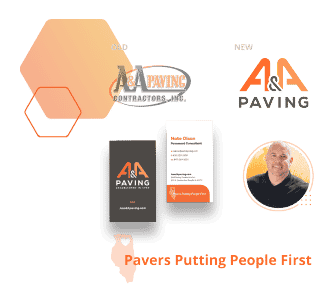
Stop what you’re doing right now and make a mental note of what’s on your pantry shelves or parked in your driveway. Those items did not get there by accident. Most of our buying behavior is driven by feelings. In other words, you chose those cookies or that car based on a feeling, rather than rational thought. As a matter of fact, we often buy based on feelings and then later rationalize our purchases with logical thought that validates those feelings. Those feelings are often connected to brands and achieved through brand development.
So, how do you stir feelings of loyalty and enthusiasm for your company’s brand? You connect with your customers on an emotional level. That starts with communicating Why you do what you do. It continues with consistent visual design and messaging. Over time, this builds trust and keeps customers loyal for life.
A quick story: I was once at a small-town fair – carnival rides, corn dogs, 4H competitions – you get the picture. There were some tractors on display and as I strolled past them, a local farmer I knew was extolling the virtues of the International Harvestor tractor line. Meanwhile, I was wearing a John Deere baseball cap (you know, to ‘fit in’ at the fair). He took one look at my hat and insulted me (in good fun). He went on to talk about why the tractor he owns is superior. When he was done, we posed for a picture standing by an International Harvestor tractor while he pointed at my hat, gave the thumbs down, and stuck his tongue out. Talk about brand loyalty.
When done well, brands turn customers into fans. And sometimes they’ll even diss the competition for you. Let’s talk about how to create those kinds of fans for your company. (And yes, branded baseball caps may be included).
How to Build Your Brand
- Discover Your “Why”
- Determine Your Brand Identity
- Develop Your Basic Brand Assets
- Create a Brand Style Guide
- Onboard Your Brand Ambassadors
- Live Your Brand
What is a Brand, And Why Does It Matter?
A brand is a series of associations, feelings, and experiences that a customer has with your business. It’s a little squishy and emotional. It’s mainly composed of your brand personality (or archetype), your actual branding (logo, tagline, colors), and your brand perception (what people think of you, both good and bad).
Branding matters because it helps you connect with people on a deeper level.
Because I grew up here and think it’s the best state in the union, here’s a list of well-developed Michigan-based brands that inspire loyalty inside and outside of our fair state:
- Bell’s Brewery (Two Hearted Ale!)
- Carhartt
- Chevy
- Kellogg’s
- Vernor’s Ginger Ale (aka, Michigan penicillin)
- Jiffy Mix
- Better Made potato chips
- Shinola watches
- Gerber baby food
- Zingermans (Legendary Reuben sandwich)
I could go on for days (Vlasic pickles vs. McClure’s pickles…both made in Michigan!) but you get the picture. You probably know at least some of these names and may even have feelings, opinions, stories, and memories of your own about them. That connection is based on great branding.
B2B Branding Matters Because People Are Involved
While it may obvious why branding matters for B2C companies, it is absolutely still relevant to small-to-medium-sized B2B companies. In the end, the decision-makers that decide to hire your company are still people and those people need to feel good about the decision to hire you.
Building a strong brand for your B2B company can help you:
- Build trust with your prospects and customers
- Communicated clearly: who you are and who you help
- Be memorable and create awareness for your company
- Stand out from your competition
Your To-Dos:
- Make a list of brands (both in and out of your industry) that you admire
- Post that list in a place you see every day as inspiration
Step 1: Discover Your “Why”
If someone asks you Why your company exists…what do you tell them?
Do you say:
- To sell a product?
- To provide jobs?
- To solve problems?
- To make money?
You need to go deeper to find your Why.
Watching Simon Sinek’s famous TedTalk: “Start With Why” is a great place to begin exploring your Why. Then sit down at your computer or with a journal and finish the following sentence:
“At (company name) we believe…”
Starting the sentence with We Believe will help steer you toward your true Why.
Warning: This is not a simple task, many companies do not know how to articulate Why they exist. They can talk about what they do and how they do it all day but are often at a loss to describe Why they do what they do.
Knowing your Why will help you:
- Gain clarity on what you believe about your company and its relationship with its customers
- Create an emotional connection between you and your customers
- Tell a compelling brand story that is true. (Ever hear of the storybrand framework?)
I asked a few clients about their Why recently and the best answer I received was from New Eagle, an engineering company located here in Ann Arbor.
Their answer:
“We exist to improve and expand the use of autonomous and electric vehicles by making it easier, faster, and more affordable to program their “brains.”
They see themselves at the forefront of the autonomous/EV movement and they’re helping development teams to bring more of these vehicles to market. They just happen to do that with software and hardware – not mentioned in their Why – because products don’t build a brand -purpose does.
Once you’ve determined your Why, share it with everyone in your company. While your Why is more of an internal-facing message, it can help inform your outward-facing messaging such as:
- Recruiting and current job postings
- Company culture and social media posts
- Marketing and Sales materials
Your To-Dos:
- Watch Simon Sinek’s video
- Document your Why and communicate it to your team
Step 2: Determine Your Brand Identity
Once you’re clear on what you believe and why you’re getting out of bed in the morning to come into the office, it’s time to determine who you are and how you’re going to show up in the world.
Understanding your brand identity or archetype can help you with this.
In a nutshell, a brand archetype is just the personality that you assign to your brand. Psychologist Carl Jung created the concept of archetypes, identifying twelve different types. Each archetype is an ideal model of a type or group or a typecast character. (Think of Captain Jack Sparrow as the archetypal Outlaw, or Dorothy from the Wizard of Oz as the archetypal Innocent.)
Every archetype represents fundamental human desires, and when you associate your brand with an archetype, you’re tapping into deep emotions that motivate your customers.
For example, we once worked with a paving company out of the Chicagoland area to help them develop a brand that truly represented their more than sixty-year-old, family-owned company.
They took our Archetype Quiz and it was determined that they were the “Caregiver” – rather unexpected for a paving company. However, this result perfectly suited them and the way they do business. From that initial archetype result, we developed:
- Tagline
- New logo
- Color palette
- Graphics
- About us copy
Everyone in their company embraced the new brand and it became a real point of pride for their team. Most importantly, they now have a brand that is worthy of them and creates a personal connection with their customers. Finally, it’s so different from everyone else in their industry that it sets them apart and makes them memorable.
Your To-Dos:
- Watch our video that explains Archetypes and how they work
- Take our Archetype Quiz & get your results
- Work through your team’s results and determine which (there can be only one!) result best suits your company.
Step 3: Develop Your Basic Brand Assets
Now that you’re clear on your brand personality, you can start to develop all of the assets you need to represent your brand:
Brand Story:
Your brand story should be factual and sum up the important points about who you are, how you came to be, why you exist, and who you’re for. It’s kind of like an origin story for a superhero. Brand stories often start with a problem or challenge and then show how the company came to exist to solve it.
NOTE: You’re not the only author of your story – your customers and their experiences will help develop your brand story over time, organically. Make sure that you are listening to your customers and hearing what they have to say.
Your brand story can be used in many different ways, but some companies use it on the About Us page, in their media kit, or on their social media channels.
Boilerplate copy:
The difference between the boilerplate and brand story is that the brand story should inspire or create a feeling while the boilerplate is used strictly to inform. It’s the who, what, when, where, why, and how of your company in one short paragraph. Your boilerplate is typically used as the ending paragraph on a press release, in the footer of your webpages, or the bottom section on sales and/or marketing collateral. It often starts with: “About ACME company….”
Elevator pitch:
The elevator pitch answers the question: “So what do you do?” It’s a compelling pitch that you would be able to deliver to a prospect during a brief elevator ride. It provides a few tantalizing details about your company and how it could help the prospect and makes them want to hear more (and not get out of the elevator on the next floor). It’s often a distilled version of your brand story and About Us paragraph but with more of a sales focus.
Voice & Tone:
A voice & tone guide is a document, mainly meant for marketing folks and copywriters to use when writing content for a company. However, it can be used by anyone who communicates on your behalf (employees, contractors, vendors, sales teams). It ensures that customers have a consistent experience with your brand no matter where they interact with you.
- Voice: Your company’s brand personality described in adjectives.
- Tone: A subset of voice. Tone shades your voice based on the audience and situation/content type.
Tagline:
Your tagline should be short and sum up your value proposition in a memorable way. Despite their short stature, they are the hardest thing you’ll ever write. Why? Because you have to sum up your company in just a few words( usually between 2 – 9 words). Your tagline is typically shown next to your logo.
Imagery:
Your brand imagery is probably the thing you’re most familiar with. It’s the result of all the visuals that represent your brand’s identity. Imagery goes beyond creating the best logo design. It includes a mix of items working together such as your color palette, graphic elements, typography treatment, photography style, and more.
Your To-Dos:
- Take an inventory of your brand assets to understand what you have and what you need to create.
- Work with a marketing professional(s) to develop brand assets that adhere to your brand style guide.
Step 4: Create a Brand Style Guide
Once you’ve created all the necessary assets, you’ll want to ensure that your brand experience is seamless no matter where your customers interact with you. To do this you’ll need to create a brand style guide – the ‘brand bible’ as it were.
The guide should include:
- Mission and Vision statements
- Defined Target Audience
- Brand Story
- Acceptable formats of your logo and tagline
- Typography treatments (headlines, body text, alignment, tracking, kerning, and size adjustments)
- Colors values including color match (Pantone values), Print (CMYK), and Digital (RGB & Hex codes)
- Image guidelines and best practices
- Voice and Tone (do’s and don’ts)
- Trademarks and copyrights (If applicable)
- Any or all of the assets mentioned in the previous step
The brand style guide is not just for your internal team, but for anyone creating anything on your behalf.
For example, if you’re sponsoring a golf outing and you’re going to be featured on signage around the course, you’ll want to share your style guide with the printing vendor or the events staff so that your logo and tagline will be printed properly.
Your To-Dos:
- Work with your marketing team or an agency to develop your style guide
Step 5: Onboard Your Brand Ambassadors
We’re not talking about hiring the Red Bulls girls here. We’re talking about your internal team. They are critical to helping you spread brand awareness but you have to tell them how to do it. If you’re launching a new brand or an update of your old brand, do a soft launch internally first. Explain your brand choices to your team and make sure they understand how to communicate the brand when they’re out in the world.
Your most loyal customers are also part of your brand ambassador team. Think about the customers that have been with you for years, maybe even decades. They probably can tell your brand story and give your elevator pitch as good or better than anyone on your sales team!
Look for ways to make it easier for your team and your customers to share your brand with the world.
Your To-Dos:
- Develop a corporate communications packet that includes the brand assets listed in Step 3 above.
- Include social share/follow buttons in your emails, on your blog, and throughout your website
- Have a referral process documented and share it with your sales and leadership teams
- Reach out for testimonial videos and written endorsements of your company and use them on social media, your website and your sales deck
Step 6: Live Your Brand
Living your brand means fully embracing it and making it a part of everything you do. This includes stopping to ask: “Is this on-brand for us?” before you buy/invest/hire/fire/respond to just about anything. Look at everything you do through the lens of your brand.
If you have a brand that you’re proud of this is easy! Some people really run with it.
If you’re having trouble living your brand that could be a red flag that you’ve either gone down the wrong road or that you have not put in the time to fully develop it.
Remember, if you’re not connecting with your brand, your customers certainly won’t.
Your To-Dos:
- Order some swag! (baseball caps, t-shirts, hats, water bottles, stickers, etc.)
- Provide social media platform branding for your employees to use if they wish (LinkedIn banners specifically).
- Think about your office decor and dress code (we hear hoodies and sweats are making a comeback) and how it reflects on your brand.
Get Help Examining And Executing Your Brand
If after reading this you’re feeling a little overwhelmed or don’t know where to start, here are a few suggestions:
- Need an overhaul of your existing brand? Take the archetype quiz to get a better idea of what your brand personality could be.
- Have an existing brand identity that you’re happy with but need to update your brand assets? Take an inventory of what brand assets you have and which ones you need to create. Then prioritize what to work on first.
- You can also get in touch with our team – we can help you identify opportunities to improve your digital brand including help design, website, and voice and tone for your messaging.
If you are raring to go like a tractor at the local fair, then chat with our brand ambassador and sales consultant, Bryan Smith.
Still Looking For Answers? We Can Help!
Get the latest news
Blog Topics
- Analytics
- Branding & Identity
- Budget
- Construction
- Content Marketing
- Conversion Rate Optimization
- Email Marketing
- HubSpot
- Inbound Marketing
- Lead Generation
- Marketing Strategy
- News/Events
- Paid Search & PPC
- Recruiting
- Sales & Marketing
- Sales Enablement
- Search Engine Marketing
- Search Engine Optimization
- Social Media
- Thought Leadership
- Uncategorized
- Usability
- Video Marketing
- Web Hosting
- Website Design

